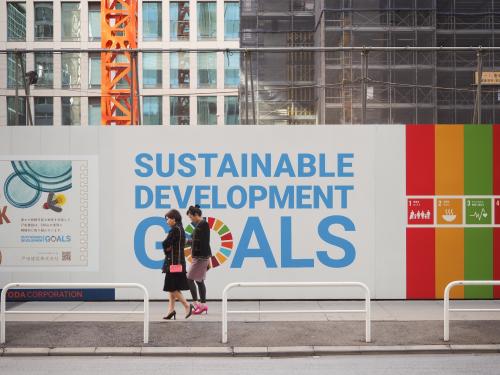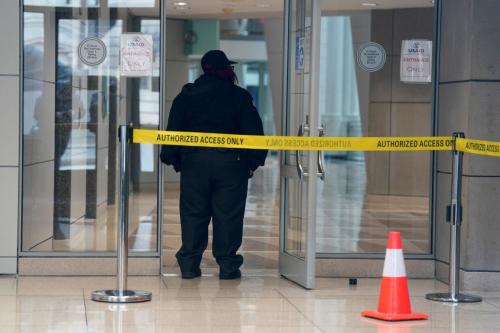With world leaders gathering in New York later this month to agree on the Sustainable Development Goals (SDGs) that will set the global agenda for the next 15 years, it is important to identify whether countries have sufficient resources to achieve these goals. The recent Oslo Summit on Education and Development put forward some important recommendations for improving financing for the education goals. The summit has set the bar high for the future of education financing, with the announcement of a high-level Commission on the Financing of Global Education Opportunities that aims to provide fresh approaches to addressing gaps in domestic and international sources of funding. In tackling the problems of education finance, it is important to look at countries where the challenges are the greatest. Pakistan is certainly one of these.
The prime minister of Pakistan, one of the speakers at the Oslo Summit, expressed strong resolve to securing the right of free quality education for every child in Pakistan by a commitment to allocating 4 percent of GDP to education. The renewed commitment to this longstanding target for the country is a welcome step, but will remain aspirational without concrete measures to make the target a reality. Our paper prepared for the summit offers some recommendations in this regard.
Pakistan faces a huge gap in financing education aims. The 2014 Education for All Global Monitoring Report estimates that Pakistan is among a small group of lower-middle-income countries that will need to roughly double relative spending on basic education to reach the goals by 2030, which would mean an increase in the proportion of GDP allocations to basic education by a factor of three. Currently the country spends no more than 2 percent of GDP on education, one of the lowest shares globally. The pledge to increase allocation to 4 percent of GDP has been repeated at the highest levels of government since 1992. While spending on education has increased in real terms in recent years, the absolute amount spent remains far below levels that are required to meet targets for access to quality education for all.
In order to improve financing for education, Pakistan needs to focus on two areas: increasing available domestic resources, and implementing a needs-based formula for the distribution of funding within provinces. The achievement of these twin objectives requires a combination of strong political will and the technical capacity to implement reforms effectively.
Increase in domestic resources. In order to spend more on education, Pakistan needs to generate additional domestic resources by strengthening the tax base. The capacity of the government to generate income through taxes is very weak at both the federal and provincial level. The tax to GDP ratio in Pakistan has remained below 10 percent for the past decade, among the lowest in the world. According to the 2014 Education for All Global Monitoring report, if the Pakistani government increased its tax revenue to 14 percent of GDP and allocated one-fifth of this to education, it could raise sufficient funds to get all of Pakistan’s children and adolescents into school. The ability to increase taxes is constrained by two interlinked factors: a lack of political will for instituting a progressive tax regime, and the need for comprehensive technocratic reforms to enhance tax collection mechanisms.
With federal transfers making up about 90 percent of the total provincial income, the need for reform of the federal tax machinery is clear. If properly designed and implemented, provincial taxes can be an important source of revenue. While the provinces raise their own taxes, on the whole this capacity is limited. On average, around just 10 percent of receipts obtained through tax revenue is retained at the provincial level. Transferring responsibility to the provinces increases the incentives for improving the efficiency of tax collection. Any reform needs to be balanced against the current system of need-based resource redistribution, recognizing that poorer provinces have fewer opportunities to raise tax revenue. Getting the right balance for provincial incentives and redistribution is crucial.
At the moment the tax regime in Pakistan is regressive, with heavy reliance on sales taxes and on taxing salaried income, burdening low and middle-income households. Tax reform remains a huge public policy hurdle, with little will within the parliament to introduce comprehensive tax reforms that bring big business and big agriculture into the tax net, address tax-evasion, and improve tax collection. Effective design and implementation of these reforms require technocratic solutions in the federal and provincial tax machineries. However, these technocratic solutions can only be achieved if there is political will to introduce them.
Development assistance remains a small but important source of financing. However, in order to reach a long-term and sustainable solution, raising internal capacity for revenue generation is crucial. The provinces’ natural resource reserves could be one such sustainable source of revenue. A key issue will be to ensure that additional revenues are invested in the country’s future development: its children.
Equitable allocation. Raising sufficient funds is just one part of the problem. Another key policy concern is the ability to allocate resources to areas most in need. As our paper shows, the redistribution of resources from the federal level to provinces has become more equitable in recent years. This is largely due to a formula that is weighted according to the province’s poverty, revenue collection or generation, and inverse population density. As a result, Baluchistan, a poorer and less densely-populated province, now receives 9 percent of central funds compared with its national population share of 5 percent.
While distribution of resources has become more equitable from the federal level, the same cannot be said within provinces. On paper, provinces are meant to allocate resources based on needs. However our analysis finds that, in all provinces, districts with the highest proportion of out-of-school children—thus indicating the greatest need—generally have the lowest education budgets. In Punjab for example, two districts—Lahore and Faisalabad—together receive 9 percent of the country’s total education budget while eight of the districts with largest number of children out of school receive 8 percent of the total budget. In Khyber Pakhtunkhwa, three of the top performing districts—Peshawar, Mansehra, and Mardan—receive 23 percent of the total budget, while four of the poorest performing districts together receive only 4 percent of the total budget. Additionally, the cost of provision is higher in more underdeveloped areas, including Baluchistan, parts of Khyber Pakhtunkhwa, and South Punjab, due to topography and insufficient basic infrastructure. A result of inadequate resources is that even when schools are available in underdeveloped areas, they are more likely to be served by single teacher schools. These schools are often of particularly poor quality, with teachers not trained to support children of diverse age groups and abilities within one classroom.
The capacity of the provinces to link resource allocations to development needs and desired outcomes must be built to improve efficiency of spending. An important aspect of this is to ensure provinces have the capacity and associated systems (such as data management information systems, and budgetary tracking and planning frameworks) to implement a needs-based formula for distribution of resources. The federal government can play a major role in providing support at the subnational level to achieve these governance goals, including with continued support from international donors.
Pakistan has a long distance to travel to achieve the proposed SDGs on education by 2030. The political leadership of the prime minister shown at the Oslo Summit, combined with reforms to raise additional resources through taxation and efforts to reach those most in need, will go a long way to making sure the country is on track to achieve these goals.
The Brookings Institution is committed to quality, independence, and impact.
We are supported by a diverse array of funders. In line with our values and policies, each Brookings publication represents the sole views of its author(s).



Commentary
Making Pakistan’s target for education financing a reality
August 27, 2015